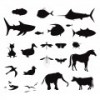A new study from Science Translational Medicine (DOI:10.1126/scitranslmed.3006534) presents data showing that tauroursodeoxycholic acid (TUDCA), a compound isolated from the bile of bears, may actually slow the development of type 1 diabetes (in mice at least). It is thought to work by reducing stress responses from the endoplasmic reticulum in the insulin-producing beta cells of the pancreas which become defective in type 1 diabetes. Use of bear bile is common in traditional Chinese medicine, and at one time led to near-extinction of black bears in China. Fortunately, synthetic versions of the compound are available and have also been shown to be effective in treating ocular diseases (DOI:10.1007/s12177-009-9030-x).
More like this
I have pointed to the fact that mtDNA genetics has suggested that the polar bear is actually a derived lineage of brown bears.
This is from Seabeck, Washington, across the water from Seattle.
I read an interesting article in the Alaska Dispatch News which examined interactions between arctic grizzly bears and polar bears. They found that although polar bears are larger, they tend to leave food sources when grizzly bears are around.
From here: "Cronin et al.

